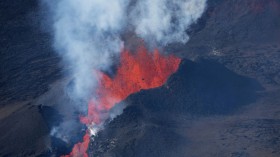Scientists have long debated whether climate change or hunting ultimately led to the extinction of woolly mammoths 10,000 years ago, which coincided with the end of the glacial period. During this time, many other giant mammals also disappeared. But researchers from the University of Michigan (U-M) have settled the debate after conducting comprehensive studies that the Siberian woolly mammoth's mass exit was a direct result of excess hunting by humans.
For their study, U-M researchers analyzed the isotopic signatures embedded in 15 tusks of juvenile Siberian woolly mammoths ranging in age from 3 to 12 years. They found that the weaning age – the time when a calf stops nursing – decreased from age 8 to a far less mature age 5 over a span of roughly 30,000 years leading up to the woolly mammoth's extinction, according to a news release. This suggests the animals were forced to mature in a hurry in order to defend themselves due to increasing pressure from hunters. (Scroll to read on...)
"This shift to earlier weaning age in the time leading up to woolly mammoth extinction provides compelling evidence of hunting pressure and adds to a growing body of life-history data that are inconsistent with the idea that climate changes drove the extinctions of many large ice-age mammals," Michael Cherney, a U-M doctoral student, said in the release.
Cherney conducted the research under the advisement of Daniel Fisher, a U-M professor and Museum of Paleontology Director, who has been collecting the Siberian mammoth tusks used for the study over the past 20 years. Using such a diverse array of species allowed the researchers to get a good range of geological ages and develop a pattern seen over time.
"This is a milestone in the development of our approach, and it shows that the extinction problem is solvable," Fisher said in the release.
To get a better idea of the isotopic effects of transitioning from nursing to fully solid diet, Cherney measured the isotopic composition of tail hairs from a mother-calf pair of African elephants living in the Toledo Zoo. He determined that as the proportion of solid food in the calf's diet increased, the isotope ratios changed. When applying this to the mammoth tusks, Cherney found the same trend existed.
"The strength of life-history analyses for resolving the extinction debate rests in the knowledge that the age of final weaning is a life-history landmark that is expected to change differently in response to predation and climate-related nutritional stress," Cherney said in a statement. "Our analysis sets up a test of competing hypotheses, and our preliminary results are consistent with expectations under hunting pressure."
Cherney recently presented their findings at a meeting of the Society of Vertebrate Paleontology in Dallas. Cherney and Fisher also plan to submit their work for publication in a scientific journal.
Related Articles
Woolly Mammoth Bones Uncovered In Michigan
Inbreeding Might have Contributed to Extinction of Woolly Mammoths
For more great nature science stories and general news, please visit our sister site, Headlines and Global News (HNGN).
-Follow Samantha on Twitter @Sam_Ashley13
© 2024 NatureWorldNews.com All rights reserved. Do not reproduce without permission.





